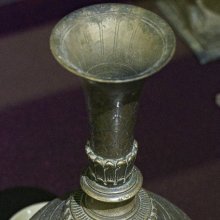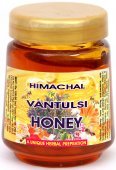Anti, Amti, Āṇṭi, Anṭī: 17 definitions
Introduction:
Anti means something in Hinduism, Sanskrit, Buddhism, Pali, Marathi, Hindi, biology, Tamil. If you want to know the exact meaning, history, etymology or English translation of this term then check out the descriptions on this page. Add your comment or reference to a book if you want to contribute to this summary article.
Images (photo gallery)
In Hinduism
Vyakarana (Sanskrit grammar)
Source: Wikisource: A dictionary of Sanskrit grammarAnti (अन्ति).—Affix of the pres. 3rd pers. pl. Paras, substituted for the original affix झि (jhi), e. g. कुर्वन्ति, भवन्ति (kurvanti, bhavanti).

Vyakarana (व्याकरण, vyākaraṇa) refers to Sanskrit grammar and represents one of the six additional sciences (vedanga) to be studied along with the Vedas. Vyakarana concerns itself with the rules of Sanskrit grammar and linguistic analysis in order to establish the correct context of words and sentences.
Biology (plants and animals)
Source: Wisdom Library: Local Names of Plants and DrugsAmti in the Kannada language is the name of a plant identified with Embelia tsjeriam-cottam (Roem. & Schult.) A.DC. from the Primulaceae (Primrose) family having the following synonyms: Embelia basaal, Embelia robusta. For the possible medicinal usage of amti, you can check this page for potential sources and references, although be aware that any some or none of the side-effects may not be mentioned here, wether they be harmful or beneficial to health.
Source: Google Books: CRC World Dictionary (Regional names)1) Amti in India is the name of a plant defined with Anodendron paniculatum in various botanical sources. This page contains potential references in Ayurveda, modern medicine, and other folk traditions or local practices It has the synonym Echites polyanthus Wall., nom. inval. (among others).
2) Amti is also identified with Bauhinia malabarica It has the synonym Casparea castrata (Hassk.) Hassk. (etc.).
3) Amti is also identified with Embelia tsjeriam-cottam It has the synonym Embelia tsjeriam-cottam A. DC. (etc.).
4) Amti in Nepal is also identified with Smithia sensitiva It has the synonym Aeschynomene tribuloides Baill. (etc.).
5) Amti in Philippines is also identified with Solanum nigrum It has the synonym Solanum nigrum var. atriplicifolium G. Meyer (etc.).
Example references for further research on medicinal uses or toxicity (see latin names for full list):
· Enumeratio Plantarum Zeylaniae (1860)
· Bulletin of the Botanical Survey of India (1974)
· Lagascalia (1980)
· Fitoterapia (1990)
· Prodromus Florae Peninsulae Indiae Orientalis (1834)
· Transactions of the Linnean Society of London (1834)
If you are looking for specific details regarding Amti, for example health benefits, pregnancy safety, chemical composition, side effects, diet and recipes, extract dosage, have a look at these references.

This sections includes definitions from the five kingdoms of living things: Animals, Plants, Fungi, Protists and Monera. It will include both the official binomial nomenclature (scientific names usually in Latin) as well as regional spellings and variants.
Languages of India and abroad
Pali-English dictionary
Source: Sutta: The Pali Text Society's Pali-English DictionaryAnti, (indecl.) (Vedic anti = Lat ante, Gr. a)nti/, Goth. and; Ags. and-, Ger. ant-, ent-) adv. & prep. c. Gen.: opposite, near J.V, 399 (tav’antiṃ āgatā, read as tav’anti-m-āgatā; C. santikaṃ), 400, 404; VI, 565 (sāmikass’anti = antike C.). — Cp. antika. (Page 48)

Pali is the language of the Tipiṭaka, which is the sacred canon of Theravāda Buddhism and contains much of the Buddha’s speech. Closeley related to Sanskrit, both languages are used interchangeably between religions.
Marathi-English dictionary
Source: DDSA: The Aryabhusan school dictionary, Marathi-Englishantī (अंती).—prep At the end of, after. Because of.
Marathi is an Indo-European language having over 70 million native speakers people in (predominantly) Maharashtra India. Marathi, like many other Indo-Aryan languages, evolved from early forms of Prakrit, which itself is a subset of Sanskrit, one of the most ancient languages of the world.
Sanskrit dictionary
Source: DDSA: The practical Sanskrit-English dictionaryAnti (अन्ति).—ind. [anta-i] Ved.
1) Near, before, in the presence of; न ही नु वो मरुतो अन्त्यस्मे (na hī nu vo maruto antyasme) Ṛgveda 1.167.9; 1.79. 11.
2) (Prep.) To, in the vicinity of (with gen.); मुग्धप्रभीतवदुपेयतुरन्ति मात्रोः (mugdhaprabhītavadupeyaturanti mātroḥ) Bhāgavata 1.8.22.
-tiḥ f. An elder sister (in dramas).
--- OR ---
Antī (अन्ती).—An oven, fire-place.
Source: Cologne Digital Sanskrit Dictionaries: Shabda-Sagara Sanskrit-English DictionaryAnti (अन्ति).—f.
(-ntiḥ) An elder sister, (in theatrical language.) ind. Near.
Source: Cologne Digital Sanskrit Dictionaries: Cappeller Sanskrit-English DictionaryAnti (अन्ति).—[adverb] opposite, in front, before, near. As [preposition] = near, toward, to ([genetive] or —°).
Source: Cologne Digital Sanskrit Dictionaries: Monier-Williams Sanskrit-English Dictionary1) Anti (अन्ति):—1. anti ind. before, in the presence of near, [Ṛg-veda; Atharva-veda]
2) (with [genitive case]) within the proximity of, to
3) cf. [Latin] ante; [Greek] ἀντί.
4) 2. anti f. an elder sister (in theatrical language), [cf. Lexicographers, esp. such as amarasiṃha, halāyudha, hemacandra, etc.] For 1. anti See [column]2.
5) Antī (अन्ती):—[from anti] f. an oven, [cf. Lexicographers, esp. such as amarasiṃha, halāyudha, hemacandra, etc.]
Source: Cologne Digital Sanskrit Dictionaries: Goldstücker Sanskrit-English DictionaryAnti (अन्ति):—I. ind. Near, in the proximity of, before, in the pre-sence of. E. According to the native etym. an abbreviation of antika; but more probably arising from a common origin with anta; see the Preface. Ii. denom. parasm.
(-ntayati) To make an end of, to destroy. E. anta, denom. aff. ṇic. Iii. f.
(-ntiḥ) (In theatrical language.) An elder sister. E. An abbrevation of antikā.
--- OR ---
Antī (अन्ती):—f.
(-ntī) A fire place, a furnace; the same as antikā Ii. E. A shorter form of antikā q. v.
Source: Cologne Digital Sanskrit Dictionaries: Yates Sanskrit-English DictionaryAnti (अन्ति):—(ntiḥ) 2. f. An elder sister.
[Sanskrit to German]
Sanskrit, also spelled संस्कृतम् (saṃskṛtam), is an ancient language of India commonly seen as the grandmother of the Indo-European language family (even English!). Closely allied with Prakrit and Pali, Sanskrit is more exhaustive in both grammar and terms and has the most extensive collection of literature in the world, greatly surpassing its sister-languages Greek and Latin.
Hindi dictionary
Source: DDSA: A practical Hindi-English dictionaryAnti in Hindi refers in English to:—(nf) fold of the loin cloth on the waist; space between any two fingers of a hand; a spool; knot; ~[baja] a swindler, cheat; —[para cadhana] to fall into hostile clutches; —[marana] to swindle..—anti (अंटी) is alternatively transliterated as Aṃṭī.
...
Kannada-English dictionary
Source: Alar: Kannada-English corpusAṃti (ಅಂತಿ):—[noun] an elder sister.
Kannada is a Dravidian language (as opposed to the Indo-European language family) mainly spoken in the southwestern region of India.
Tamil dictionary
Source: DDSA: University of Madras: Tamil LexiconAnti (அந்தி) noun probably from andha. Blinding tree. See தில்லை. (வைத்திய மலையகராதி) [thillai. (vaithiya malaiyagarathi)]
--- OR ---
Anti (அந்தி) noun probably from anta. Dissolution of the universe at the end of a kalpa; ஊழிமுடிவு. படரணி யந்திப் பசுங்கடவுள் [uzhimudivu. padarani yanthip pasungadavul] (கலித்தொகை [kalithogai] 101, 24).
--- OR ---
Anti (அந்தி) noun < sandhi.
1. Twilight, as joining day with night; சந்தியா காலம். காலை யந் தியு மாலை யந்தியும் [santhiya kalam. kalai yan thiyu vaithiya malaiyagarathi yanthiyum] (புறநானூறு [purananuru] 34).
2. Evening twilight; மாலை. அந்தியம்போ திதுவாகும் [vaithiya malaiyagarathi anthiyambo thithuvagum] (நாலாயிர திவ்யப்பிரபந்தம் பெரிய.ாழ். [nalayira thivyappirapandam periyazh.] 2, 8, 1).
3. Red glow of sunset; செவ்வானம். அந்திவண் ணர் [sevvanam. anthivan narrinai] (பெரியபுராணம் அமர்நீதி. [periyapuranam amarnithi.] 3).
4. Morning and evening prayers; சந்தியாவந்தனம். ஓதி யுருவெண்ணு மந் தியால் [santhiyavanthanam. othi yuruvennu man thiyal] (நாலாயிர திவ்யப்பிரபந்தம் இயற். [nalayira thivyappirapandam iyar.] 1, 33).
5. Night; இரவு. அந்திகாவலன் [iravu. anthigavalan] (நாலாயிர திவ்யப்பிரபந்தம் பெரியதி. [nalayira thivyappirapandam periyathi.] 8, 5, 1).
6. Intersection of three streets; முச்சந்தி. அந்தியுஞ் சதுக்கமு மாவண வீதியும் [muchanthi. anthiyugn sathukkamu mavana vithiyum] (சிலப்பதிகாரம் அரும்பதவுரை [silappathigaram arumbathavurai] 14, 213).
7. (Music) An ancient secondary melody-type of the pālai class; பாலை யாழ்த்திறவகை. (பிங்கலகண்டு) [palai yazhthiravagai. (pingalagandu)]
--- OR ---
Anti (அந்தி) [antittal] 11 transitive verb < idem.
1. To unite, join, meet; சந்தித்தல். யமபடையென வந்திக் குங் கட்கடையாலே [santhithal. yamapadaiyena vanthig kung kadkadaiyale] (திருப்புகழ் [thiruppugazh] 85).
2. To approach; கிட்டுதல். வேதமந்தித்து மறியான் [kittuthal. vethamanthithu mariyan] (திருவிளையாடற் புராணம் நகர. [thiruvilaiyadar puranam nagara.] 106).
3. To tie up in a knot; முடித்துவைத்தல். அந்தித் திருக்கும் பொருளில்லை [mudithuvaithal. anthith thirukkum porulillai] (திருவாலவாயுடையார் திருவிளையாடற் [thiruvalavayudaiyar thiruvilaiyadar]
30. 14).
--- OR ---
Āṇṭi (ஆண்டி) noun < idem. [K.M. āṇḍi.]
1. A class of Non-Brāhman Śaivas; பண்டாரம். [pandaram.]
2. Non-Brāhman Śaiva mendicant, usually dressed in yellow cloth: பரதசாஸ்திரம்ேசி. [parathesi.]
3. A masquerade dance; வரிக்கூத்துவகை. [varikkuthuvagai.] (சிலப்பதிகாரம் அரும்பதவுரை [silappathigaram arumbathavurai] 3, 13, உரை. [urai.])
--- OR ---
Anti (அந்தி) [antittal] 11 intransitive verb < anta. To fit in; பத்துப்பாட்டு: பொருநராற்றுப்படை்துதல். (அகராதி நிகண்டு) [porunthuthal. (agarathi nigandu)]
--- OR ---
Anti (அந்தி) particle < அந்தில். [anthil.] An expletive; ஓர் அசைச்சொல். (பொதிகை நிகண்டு) [or asaichol. (pothigai nigandu)]
--- OR ---
Āṇṭi (ஆண்டி) noun < ஆள்-. [al-.] Poor man; ஏழை. [ezhai.] Local usage
Tamil is an ancient language of India from the Dravidian family spoken by roughly 250 million people mainly in southern India and Sri Lanka.
See also (Relevant definitions)
Starts with (+126): Amtibale, Amtidu, Amtiduvale, Amtigepamtige, Amtikku, Amtimadarshana, Amtimakarana, Amtimanamana, Amtimaprabheda, Amtimapranama, Amtimaprayana, Amtimayatre, Amtimtu, Amtire, Amtirevol, Amtirike, Amtisu, Anti-aging, Anti-maduram, Anti-malari.
Ends with (+1365): Aanakoranti, Abanti, Abhikranti, Abhranti, Abhrayanti, Abravanti, Acakanti, Acanti, Acuvakanti, Acyudanti, Acyutadanti, Acyutanti, Adamti, Adavi banti, Adavigoramti, Adbhutashanti, Addapamti, Adhanti, Adhikranti, Adhimatrakshanti.
Full-text (+402): Rakshasya, Antimitra, Andi, Antim, Antyuti, Antitara, Antideva, Cataiyanti, Anticamati, Antika, Anti-mantaram, Antigriha, Antivama, Antiyulavu, Antimalarntan, Antimanti, Antishumna, Asamajika, Antippulavar, Antikuppu.
Relevant text
Search found 117 books and stories containing Anti, Aandi, Aanti, Amti, Aṃti, Andi, Anthi, Antī, Āṇṭi, Anṭī; (plurals include: Antis, Aandis, Aantis, Amtis, Aṃtis, Andis, Anthis, Antīs, Āṇṭis, Anṭīs). You can also click to the full overview containing English textual excerpts. Below are direct links for the most relevant articles:
Middle Chola Temples (by S. R. Balasubrahmanyam)
Temples in Sengunram < [Chapter II - Temples of Rajaraja I’s Time]
Yoga Vasistha [English], Volume 1-4 (by Vihari-Lala Mitra)
Chapter xxxvi < [Book III - Utpatti khanda (utpatti khanda)]
The Unknown Citizen Made Known < [July – September, 1995]
Paradoxism - The Last Literary Vanguard of the < [April – June, 2001]
What is True Education? < [April – June, 2008]
Dramaturgy in the Venisamhara (by Debi Prasad Namasudra)
The Heroine of the Dramatic Play < [Chapter 4 - Dramaturgy in Veṇīsaṃhāra]
Charaka Samhita (English translation) (by Shree Gulabkunverba Ayurvedic Society)
Chapter 4 - Six Hundred Purgative Preparations (virecana-ashraya) < [Sutrasthana (Sutra Sthana) — General Principles]
Chapter 11 - The Pharmaceutics of the Soap-pod and Clenolepis < [Kalpasthana (Kalpa Sthana) — Section on Pharmaceutics]
Chapter 20 - The therapeutics of Vomiting (chardi-cikitsa) < [Cikitsasthana (Cikitsa Sthana) — Section on Therapeutics]
Rig Veda (translation and commentary) (by H. H. Wilson)
Related products
(+152 more products available)








